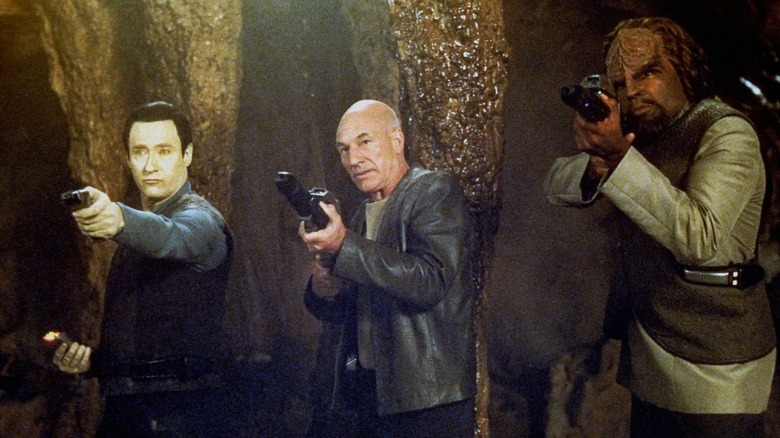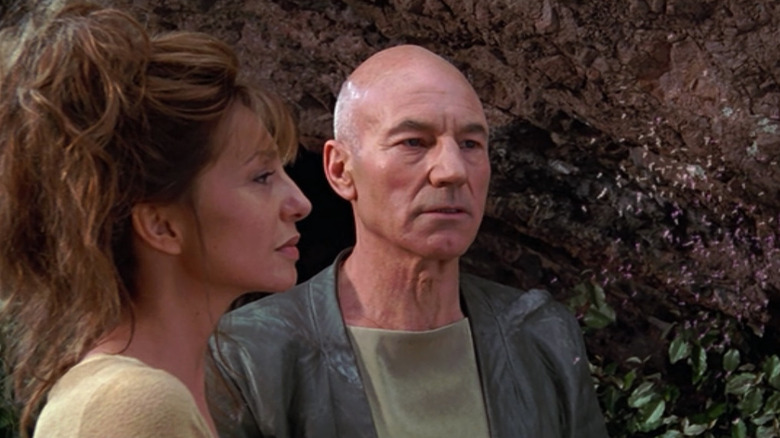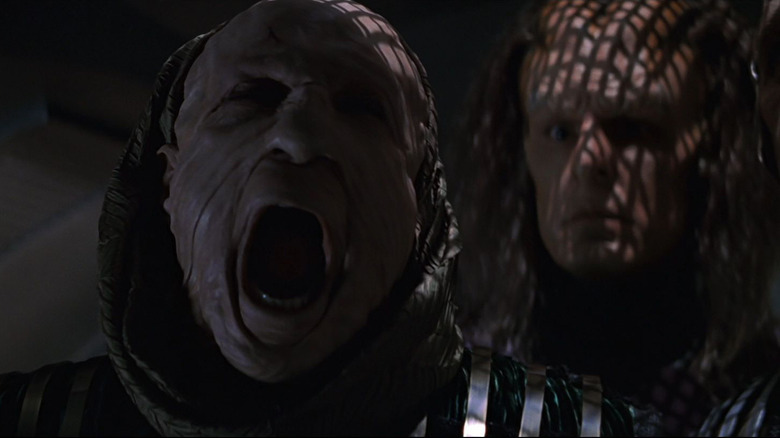
Any good Trekkie who was attending conventions in the late 1990s likely caught wind of multiple unrealized Trek projects — some of them actual, most of them apocryphal. The history of "Star Trek" is punctuated by multiple failed projects or unmade ideas that remain but a distant dream of the casual fan-child. Most frequently mentioned among the Treks not taken is "Star Trek: Phase II," a revival set for release in the 1970s, for which footage was filmed, but was ultimately scrapped in favor of "Star Trek: The Motion Picture."
While "Star Trek: Insurrection" (1998) was a modestly mounted film — it had a lower budget than its "TNG"-inspired predecessors and a less "movie-ready" premise — it began with much greater ambitions. The current version of "Insurrection" is about a remote planet in a difficult-to-get-to part of the galaxy that — thanks to its radioactive rings — provides a mysterious cell-renewing quality to the people below. It's an agrarian society of placid immortals. Picard and crew must defy Federation orders to stop a sinister Admiral and a race of cosmetic surgery-addicted bad guys from harvesting the radiation and forcibly relocating the immortal locals. It borrowed elements from the NextGen episodes "Who Watches the Watchers?" and "Journey's End."
Executive producer Michal Piller, one of the head honchos of "Star Trek" in 1998, had a better idea at first. Inspired by the 1902 novella "Heart of Darkness" by Joseph Conrad — the inspiration for Francis Ford Coppola's 1979 psychedelic Vietnam tragedy "Apocalypse Now" — Piller wrote a screenplay called "Star Trek: Stardust" about Picard traversing a dangerous portion of space to rescue a lost soldier who believed that Romulans are planning on destroying the world.
Hugh Duffy

In an interview with StarTrek.com, Piller described the project a little bit: "Stardust" was to feature a character named Hugh Duffy who had become obsessed with something called sarium krellide, a mysterious valuable mineral, and an imagined Romulan plot to destroy Earth in order to get it. Whether or not this Hugh Duffy was once Lt. Duffy (Charley Lang) from the "Star Trek: The Next Generation" episode "Hollow Pursuits" was ambiguous, but Piller's plan was to bring back multiple notable supporting players from "Next Generation" back into the movie.
Piller also wanted to include Boothby (Ray Walston), the aged groundskeeper at Starfleet Academy that Picard and many others knew when they were young, and who had been seen in the "NextGen" episode "The First Duty" and the "Star Trek: Voyager" episode "In the Flesh." At the conclusion of "Stardust," Picard would have done something horrible that involved violating Starfleet's orders, and the film's final scene would be Picard on trial for his actions. To keep the ending deliberately unclear, the audience wouldn't know if Picard was to be punished. Boothby was to initiate a slow clap at the conclusion of the scene.
"Star Trek: Stardust" was also going to feature a more prominent role for Lt. Reginald Barclay (Dwight Schultz) a semi-regular on NextGen. Barclay was a brilliant engineer, but was neurotic to the bone, no doubt about it. Early memos from the studio, however, felt that the expanded role for Barclay was taking screen time away from the actual series regulars. Lt. Barclay had previously appeared in one notable scene in "Star Trek: First Contact" (1996).
Wresting With Darkness

Generally speaking, "Star Trek" has always possessed an optimistic bent, based on Gene Roddenberry's idealistic version of a future without war or prejudice and based in egalitarianism. This doesn't mean, however, that "Trek" could not venture into some very dark places. "Next Generation" featured several desperate war scenarios with murder, hostages, and torture. "Star Trek: Deep Space Nine" went even further, setting its action after the occupation of an oppressed planet by a Nazi-like fascist species. DS9 had many stories about recovering from attempted genocide, the dark impulses brought on by war, and the intergenerational trauma that leaves behind.
The "Star Trek" movies, by contrast, have frequently wrestled with how darker, more difficult material should be handled. It's telling that the most financially successful "Star Trek" movie (until 2009) was the comedy film set in the present day about saving whales. Jonathan Frakes, who played Commander Will Riker and who directed "First Contact" and "Insurrection," is on record saying that the people wanted "Star Trek" to be more action-oriented. As such, thrills and fights and explosions were the word of the day, and the usually staid "NextGen" characters were now seen frequently wielding weapons, murdering bad guys, and flinging out one-liners like "Lock 'n' load." In retrospect, it was all a little embarrassing.
Because of the more cavalier tone struck by Frakes, a downbeat, intense sci-fi drama about a psychologically tortured character was off the table. A "Star Trek" film was not permitted to be so dark, even if the shows that preceded it were. "Stardust" was taken off the table, and "Insurrection" was put in its place. "Insurrection" was not critically lauded or financially successful. The following film, "Star Trek: Nemesis" (2002), was darker and more violent. It did even worse than "Insurrection."
Incidentally, a "Heart of Darkness"-inspired sci-fi story would eventually grace screens in the form of James Gray's 2019 film "Ad Astra." In that film, Brad Pitt played an astronaut in the near future who was tasked with traveling to Neptune to find a mad scientist who was somehow releasing shockwaves throughout the whole galaxy and threatening life on Earth. To add a Freudian twist, the mad scientist also happened to be Pitt's father. The journey in "Ad Astra" is very similar to "Heart of Darkness," as is its conclusion. We may never have had a "Star Trek" rendition of "Heart of Darkness," but we do have a pretty good sci-fi version nonetheless.
Read this next: Star Wars Movie Villains Ranked Least To Most Powerful
The post Star Trek: Insurrection Could Have Been the Franchise's Apocalypse Now appeared first on /Film.
0 Commentaires